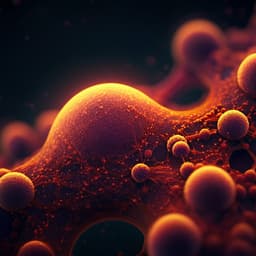
Space Sciences
How, when and where current mass flows in Martian gullies are driven by CO₂ sublimation
L. Roelofs, S. J. Conway, et al.
This fascinating research by Lonneke Roelofs and colleagues reveals how CO₂ sublimation processes, not water, may drive the formation of Martian gullies, challenging our understanding of these intriguing features on Mars.
~3 min • Beginner • English
Introduction
Martian gullies comprise alcoves, channels, and depositional aprons and have sparked debate due to implications for Mars’ water cycle, habitability, and exploration. While their morphometry and sedimentology resemble aqueous debris-flow systems on Earth, present-day gully activity (new lobate deposits, channel incision, boulder movement, bank collapse, early initiation stages) occurs under conditions unfavorable to stable liquid water. Observed activity often happens on slopes too low for dry flows, implying fluidization. A strong temporal link between activity and surface CO₂ frost suggests sublimation-driven processes. Two main CO₂-related hypotheses exist: (a) sediment–CO₂ ice mixtures fluidized by gas flux from sublimating CO₂; (b) pressurized flows beneath a translucent CO₂ slab ice with basal sublimation from solar radiation (limited to >40°S where slab ice occurs). Key challenges remain due to lack of in-situ observations to confirm how CO₂ sublimation drives granular flows and incomplete understanding of the local climatic and topographic boundary conditions controlling where activity does and does not occur at specific gullies. This study proposes and tests a framework in which CO₂ frost on cold slopes and adjacent warmer slopes interact during slope failures to generate gas pore pressure sufficient to reduce intergranular friction and drive flows over long distances and low gradients via two mechanisms: (1) frost-coated material mixing with warmer surfaces, and (2) warm sediment overrunning CO₂-frosted surfaces.
Literature Review
Prior work proposed multiple drivers of Martian gully formation and activity: melting of near-surface ground ice or brines and aqueous debris flows during high obliquity; CO₂ frost sublimation processes including gas-fluidized sediment and slab-ice basal sublimation; and hybrid temporal scenarios. Observations link contemporary activity with seasonal CO₂ frost occurrence, yet stable liquid water is unlikely under current conditions and melting pure water is difficult. Slab-ice mechanisms likely apply only where slab ice is observed (>40°S). Studies document modern activity (new lobes, channel incision, boulder motion) and frost distributions, and analyses highlight flows depositing on low slopes implying fluidization. Previous lab studies suggested CO₂-sublimation-triggered mass wasting and gas fluidization, and modeling predicted CO₂-driven debris flows under certain conditions. However, comprehensive physical tests under Martian pressure and local climatic boundary assessments were lacking; this work addresses those gaps.
Methodology
The study combines controlled flume experiments under Martian atmospheric pressure with a 1D atmospheric–subsurface column climate model to test two CO₂-driven mechanisms and their boundary conditions.
- Experimental setup: Performed in the Open University Mars chamber (0.9 m diameter, 1.8 m length), depressurized to ~800 Pa. A small-scale debris-flow flume comprised a reservoir with trap door (2.07 L), a narrow chute (7×15×70 cm) at 30° with heated aluminum base (to 20 °C) and sandblasted roughness, and an outflow plain (30×80 cm) at 12° covered with sandpaper. Two laser distance sensors (OADM 20U2480/S14C) above the chute at 0.37 m and 0.54 m recorded flow thickness at 10 kHz with sub-mm precision.
- Materials: 1 kg of moderately sorted sub-rounded fluvial sand (median grain size ~310 µm) per run. CO₂ ice was manually crushed to similar grain size. For mixed runs, initial CO₂ ice mass was 0.3 kg; ~50% sublimated during chamber depressurization to equilibrium, leaving ~0.15 kg CO₂ available during flow. For bed-frost runs, a ~2 mm-thick crushed CO₂ frost layer was placed on the chute floor.
- Experiments: Four primary experiments (each duplicated): (1) Mechanism 1 (mixture of sand + CO₂ ice released onto a heated, ice-free chute at 20 °C; Martian pressure). (2) Mechanism 2 (warm sand at 20 °C flowing over CO₂-frosted chute; Martian pressure). (3) Reference without CO₂ at Martian pressure (sediment only). (4) Reference with CO₂ at Earth atmospheric pressure (~1020 hPa). Procedure included loading, sealing, depressurizing to 800 Pa over 10–12 min (for Martian runs), releasing via trap door, and post-run photogrammetry (40–50 images; DEMs/orthophotos at ~300 µm pixel size via Agisoft Metashape).
- Scaling considerations: While gravity was not directly scaled, dimensional analysis showed under Martian gravity only ~0.38 of the CO₂ volume flux is needed to fluidize compared to Earth, implying even more effective fluidization on Mars for similar conditions.
- Climate modeling: A 1D column version of the Mars Planetary Climate Model (PCM) with slope solar irradiance scheme simulated surface temperatures and CO₂ frost condensation/sublimation on slopes of 0°, 15°, and 35° across latitudes and orientations (N, S, E, W) at 1° latitudinal resolution. Orbital parameters: obliquity 25°, perihelion Ls 251°. Surface pressure fixed at 610 Pa (tests at 500/800 Pa similar). Soil model with 18 layers; bare soil albedo 0.2 (tests at 0.1, 0.05 similar). Thermal inertia (TI) values: 750, 1000, 1250 J m−2 s−1/2 K−1. To match observed CO₂ frost, relatively high TIs were used. Two scenarios evaluated:
• Mechanism 1: Temperature differences when a 35° pole-facing frosted slope (TI 1000) is adjacent to a flat, defrosted surface (TI 1000).
• Mechanism 2: Temperature differences between neighboring slopes with differing TI: a 35° slope with high TI (1250; bedrock-like) versus a 15° slope with lower TI (750; unconsolidated), shown for south-facing orientation. Temperature differences were reported only when the reference surface was at the CO₂ frost point (i.e., frost present) and the neighbor was above frost temperature. Two Mars years were simulated; analyses used the second year. Model outputs were compared to compiled observations of present-day gully activity and frost occurrences.
Key Findings
- CO₂ sublimation fluidizes granular flows under Martian atmospheric pressure: Mechanism 1 and 2 experiments produced strongly fluidized flows with frontal velocities >2 m/s (e.g., u ≈ 2.1 m/s and 2.3 m/s), multiple surges, increased flow depth, elongated lobate deposits, and internal levees indicative of grain segregation and complex velocity profiles.
- Necessity of CO₂ and low pressure: Control runs without CO₂ under Martian pressure and with CO₂ under Earth pressure (~1020 hPa) did not show fluidization, highlighting the combined requirement of CO₂ sublimation and low atmospheric pressure.
- Process physics: Sublimation-induced gas flux increases pore pressure, reducing intergranular friction and enabling sustained runout on low gradients. Dimensional analysis indicates that under Martian gravity only ~0.38 of the CO₂ volume flux needed on Earth is required for fluidization; an equivalent Martian-gravity test of Mechanism 1 could fluidize 1 kg sediment with ~58 g of CO₂ (volume fraction ~5.8×10−2), consistent with predicted CO₂ fractions for Martian gullies.
- Thermal energy availability: Experiments used heated chute surfaces (to ~20 °C) to represent maximum modeled temperature contrasts; maximum modeled CO₂ ice–adjacent slope temperature differences reach ~140 °C, ensuring ample energy for sublimation.
- Climate-model boundary conditions align with observations: 1D PCM simulations show co-occurrence of frosted and adjacent warmer slopes at appropriate times and latitudes for both mechanisms. The envelope of modeled temperature differences overlaps the timing and latitude of observed present-day gully activity, especially for Mechanism 1 and south-facing cases of Mechanism 2. Model predictions of inactivity at certain latitudes (e.g., most equator-facing and lower-latitude northern gullies) match current lack of observed activity, with exceptions explainable by local pole-facing facets or TI contrasts.
- Morphological similarity: Experimental deposits exhibit levees and lobes similar to Martian gully deposits, supporting analogous flow dynamics to debris flows and pyroclastic density currents.
- Implications for water requirement: Results indicate liquid water is not required to explain present-day activity; CO₂-driven processes likely account for much of the observed modern gully sediment transport.
Discussion
The integrated experimental and modeling results demonstrate that CO₂ sublimation can generate sufficient pore pressure to fluidize and transport sediment in Martian gullies under present atmospheric conditions, providing a mechanistic explanation for observed modern activity without invoking liquid water. The two proposed mechanisms—(1) failure of frost-coated material onto warmer surfaces and (2) warm sediment overrunning frosted surfaces—are physically viable, sustained by sublimation energy from nearby warmer slopes, and create deposits resembling those seen on Mars. The 1D climate model shows that the necessary thermal contrasts between frosted and defrosted neighboring slopes occur seasonally at latitudes and orientations consistent with documented activity, thereby linking process physics with environmental boundary conditions. This reconciles observations of low-slope runout, seasonality tied to CO₂ frost, and deposit morphology. The results suggest that contemporary gully evolution is predominantly sublimation-driven, reducing the necessity for liquid water in modern processes. This affects interpretations of gully landforms, their paleoenvironmental implications, and astrobiological inferences, and extends to other low-pressure planetary bodies where similar landforms may not require liquid flows.
Conclusion
This study provides the first direct experimental evidence that CO₂ sublimation under Martian atmospheric conditions can fluidize and sustain granular flows via two plausible mechanisms, producing morphologies akin to Martian gully deposits. Complementary 1D climate modeling identifies when and where adjacent frosted and warm slopes co-occur, matching the timing and distribution of observed present-day gully activity. Together, these findings indicate that present-day Martian gully activity can be explained without liquid water, implying a reduced role for aqueous processes in recent gully evolution and prompting reevaluation of gully-related interpretations on Mars and other bodies. Future work should pursue in-situ observations of active events, detailed sedimentological analyses of deposits, improved local-scale climate–thermophysical modeling (including subsurface ice, surface CO₂ effects, and IR fluxes), and experiments exploring broader material properties and gravity scaling to refine quantitative constraints.
Limitations
- No in-situ observations of active gully events on Mars; conclusions rely on laboratory analogs and remote sensing.
- Experiments conducted under Earth gravity; although scaling argues fluidization would be more effective on Mars, direct Martian-gravity tests were not performed.
- Experimental boundary conditions simplified (e.g., limited CO₂ replenishment, controlled temperatures, specific grain-size distribution).
- 1D climate model omits some processes (e.g., explicit subsurface water ice, direct effects of surface CO₂ ice on energy budget, incident infrared flux), necessitating use of relatively high thermal inertia values to match observed frost occurrences.
- Local topographic complexity and microclimate heterogeneity are simplified (e.g., representation of adjacent surfaces and orientations), and 1D columns cannot capture horizontal advection effects.
- Mechanisms’ initiation triggers (e.g., rockfalls, marsquakes) are not explicitly modeled.
Related Publications
Explore these studies to deepen your understanding of the subject.







